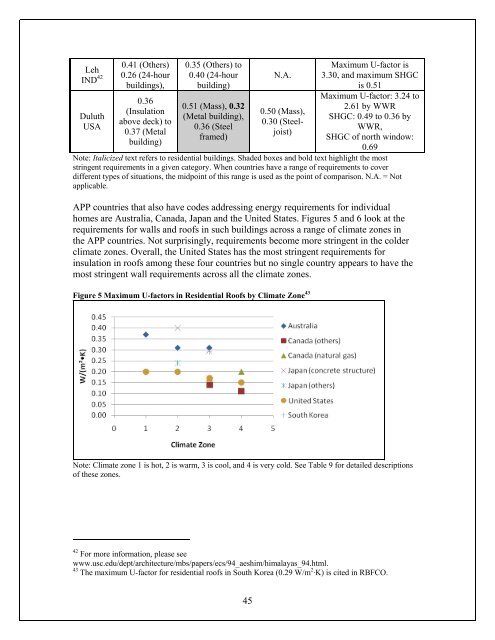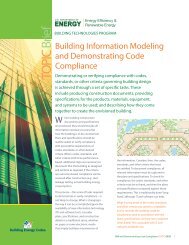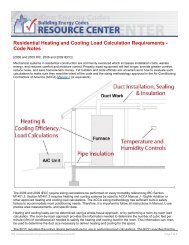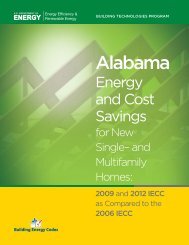Shaping the Energy Efficiency in New Buildings - Building Energy ...
Shaping the Energy Efficiency in New Buildings - Building Energy ...
Shaping the Energy Efficiency in New Buildings - Building Energy ...
You also want an ePaper? Increase the reach of your titles
YUMPU automatically turns print PDFs into web optimized ePapers that Google loves.
LehIND 42DuluthUSA0.41 (O<strong>the</strong>rs)0.26 (24-hourbuild<strong>in</strong>gs),0.36(Insulationabove deck) to0.37 (Metalbuild<strong>in</strong>g)0.35 (O<strong>the</strong>rs) to0.40 (24-hourbuild<strong>in</strong>g)0.51 (Mass), 0.32(Metal build<strong>in</strong>g),0.36 (Steelframed)N.A.0.50 (Mass),0.30 (Steeljoist)Maximum U-factor is3.30, and maximum SHGCis 0.51Maximum U-factor: 3.24 to2.61 by WWRSHGC: 0.49 to 0.36 byWWR,SHGC of north w<strong>in</strong>dow:0.69Note: Italicized text refers to residential build<strong>in</strong>gs. Shaded boxes and bold text highlight <strong>the</strong> moststr<strong>in</strong>gent requirements <strong>in</strong> a given category. When countries have a range of requirements to coverdifferent types of situations, <strong>the</strong> midpo<strong>in</strong>t of this range is used as <strong>the</strong> po<strong>in</strong>t of comparison. N.A. = Notapplicable.APP countries that also have codes address<strong>in</strong>g energy requirements for <strong>in</strong>dividualhomes are Australia, Canada, Japan and <strong>the</strong> United States. Figures 5 and 6 look at <strong>the</strong>requirements for walls and roofs <strong>in</strong> such build<strong>in</strong>gs across a range of climate zones <strong>in</strong><strong>the</strong> APP countries. Not surpris<strong>in</strong>gly, requirements become more str<strong>in</strong>gent <strong>in</strong> <strong>the</strong> colderclimate zones. Overall, <strong>the</strong> United States has <strong>the</strong> most str<strong>in</strong>gent requirements for<strong>in</strong>sulation <strong>in</strong> roofs among <strong>the</strong>se four countries but no s<strong>in</strong>gle country appears to have <strong>the</strong>most str<strong>in</strong>gent wall requirements across all <strong>the</strong> climate zones.Figure 5 Maximum U-factors <strong>in</strong> Residential Roofs by Climate Zone 43Note: Climate zone 1 is hot, 2 is warm, 3 is cool, and 4 is very cold. See Table 9 for detailed descriptionsof <strong>the</strong>se zones.42 For more <strong>in</strong>formation, please seewww.usc.edu/dept/architecture/mbs/papers/ecs/94_aeshim/himalayas_94.html.43 The maximum U-factor for residential roofs <strong>in</strong> South Korea (0.29 W/m 2·K) is cited <strong>in</strong> RBFCO.45
















